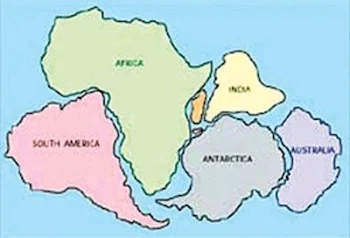Tectonic plates are giant pieces of the Earth's crust.
Tectonic plates under the sea are called oceanic plates.
Those not under water are called continental plates.
All are moving, slowly.
The top layer of the Earth’s crust is covered by giant pieces called tectonic plates. There are seven large plates and several smaller ones, all moving very slowly at different speeds (2cm to 10cm a year), and in different directions.
Those under the oceans are called oceanic plates. Those under continents are called continental plates.
The Earth was one huge continent that broke into smaller pieces which then moved slowly to be in the position they are today. ©Getty
The study of the movements and formations by geologists is called 'plate tectonics.' It is believed that plate tectonics is the reason for the movement of the continents hundreds of millions years ago from one huge landmass into the positions where they are now.
Where plates meet
The place where two plates meet is a boundary, and it is at these boundaries where new crust forms and old crust is returned to the core to be melted again. The cycle of crust forming and later melting down in the core takes about 100 million years.
Divergent boundaries
At some boundaries, called divergent boundaries, the plates move away from each other, and the very top layer of the crust (the lithosphere) breaks and the space that forms sinks down into the second layer of the crust (the asthenosphere) to form a valley called a rift. Liquid rock called magma seeps up to fill cracks. It hardens and becomes a new part of the Earth’s crust.
Convergent boundaries
At other boundaries, called convergent boundaries, two tectonic plates come together, pushing against each other, forcing one up causing mountain ranges, including volcanoes, to form. The other plate is forced downwards and its edge eventually sinks into the core and melts. Large and small earthquakes occur along these boundaries.
Transform boundaries
At transform boundaries, two plates slide against each other as they move past in different directions. As they slide past each other, neither one is destroyed or pushed. The movement causes energy to build up, which may be released as earthquakes.
Explore geography videos on volcanoes at NeoK12
Watch a video here: https://youtu.be/RA2-Vc4PIOY
Gondwanaland
For hundreds of millions of years, all the land of Earth was joined together in one large mass or super continent. Scientists call it Pangaea (meaning "all lands" in Greek)
Then about 200 million years ago the land began to drift apart. It broke into two pieces, and scientists have called the continent in the north Laurasia and the continent in the south Gondwanaland. Gondwanaland included what we know as Antarctica, which was joined to South America, Africa, India, and Australia.
The two large continents continued to break apart into the smaller continents that exist today. Scientists call this movement 'continental drift'
See illustrations of how the continents drifted apart
http://pubs.usgs.gov/publications/text/historical.html
Gondwanaland was named by Eduard Suess, an Austrian geologist. He named it after a district in India where the fossil plant Glossopteris was found. Suess said that because this fossil plant could be found in India, South America, southern Africa, Australia, and Antarctica, then all the lands must once have been joined together.
Gondwanaland was a hot and dry place with rainy seasons. The first tree ferns and coniferous trees appeared there. Dinosaurs lived there at one time too.
Read about dinosaurs on the kidcyber
How did the continents move apart?
The top layer of the Earth's crust is made up of large sections called tectonic plates. Some are oceanic plates, located in the oceans, and some are continental plates carrying continents on top of them. The plates all move very very slowly and in different directions. Where they meet is called a boundary. At some boundaries the plates move apart and liquid rock seeps into the valley that results. It hardens and becomes new crust. At some boundaries two plates collide, and one is forced up, forming mountains. The other is forced down and part of it goes into the Earth's core and melts. At other boundaries, the two plates grind together as they pass in different directions, but neither is changed. Earthquakes occur along the boundary as the plates grind each other.


